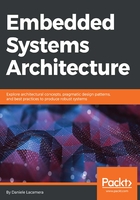
The Cortex-M microprocessor
The main characteristic of the 32-bit cores in the Cortex-M family are:
- 16 generic-purpose CPU registers
- Thumb 16-bit only instructions for code density optimizations
- Built-in Nested Vector Interrupt Controller (NVIC) with 8 to 16 priority levels
- ARMv6 (M0, M0+) or ARMv7 (M3, M4, M7) architecture
- Optional 8-region memory protection unit (MPU)
The total memory address space is 4 GB. The beginning of the internal RAM is typically mapped at the fixed address of 0x20000000. The mapping of the internal flash, as well as the other peripherals, depends on the silicon manufacturer. However, the highest 512 MB (0xE0000000 to 0xFFFFFFFF) addresses are reserved for the System Control Block (SCB), which groups together several configuration parameters and diagnostics that can be accessed by the software at any time to directly interact with the core.
Synchronous communication with peripherals and other hardware components can be triggered through interrupt lines. The processor can receive and recognize a number of different digital input signals and react to them promptly, interrupting the execution of the software and temporarily jumping to a specific location in the memory. Cortex-M supports up to 240 interrupt lines on the high-end cores of the family. The interrupt vector, located at the beginning of the software image in flash, contains the addresses of the interrupt routines that will automatically execute on specific events. Thanks to the NVIC, interrupt lines can be assigned priorities, so that when a higher-priority interrupt occurs while the routine for a lower interrupt is executed, the current interrupt routine is temporarily suspended to allow the higher-priority interrupt line to be serviced. This ensures minimal interrupt latency for these signal lines, which are somewhat critical for the system to execute as fast as possible.
At any time, the software on the target can run in two privilege modes: unprivileged or privileged. The CPU has built-in support for privilege separation between system and application software, even providing two different registers for the two separate stack pointers. We will examine in more detail how to properly implement privilege separation, and how to enforce memory separation when running untrusted code on the target.
A Cortex-M core is present in many microcontrollers, from different silicon vendors. Software tools are similar for all the platforms, but each MCU has a different configuration to take into account. Convergence libraries are available to hide manufacturer-specific details and improve portability across different models and brands. Manufacturers provide reference kits and all the documentation required to get started, which are intended to be used for evaluation during the design phase, and may also be useful for developing prototypes at a later stage. Some of these evaluation boards are equipped with sensors, multimedia electronics, or other peripherals that extend the functionality of the microcontroller.